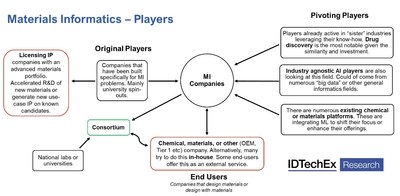 BOSTON » Aug. 27, 2020
BOSTON » Aug. 27, 2020
, /PRNewswire/ — Materials informatics is quickly becoming one of the most significant areas of interest for chemical and material companies. There have been significant early adopters, notable news stories, internationally renowned consortia established, large funding rounds, and still many yet to get started. Navigating a successful path is challenging, a misstep could have a large implication on cost and competitive advantage.
There are many facets to materials informatics and many routes for a company to engage with this area. IDTechEx has written a brand-new report on ; this technical industry assessment provides the reader with primary interview-based profiles of the key technology providers, case studies across a wide range of application areas, and roadmaps & outlooks for the rate and scale of adoption.
what materials informatics encompasses » why an inflexion point is approaching » market report
For more details on and see previous articles and the .
For a company wanting to use materials informatics there are three main approaches: partner with a company, join a public-private consortium, or go it alone and develop the capabilities in house.
The external MI players can come from numerous starting points, as outlined in the figure below. Dedicated MI companies have the advantage of years of experience and a product or service already well-tailored to the needs. Many have received notable investments and built a software team that is impossible to replicate overnight. The main downside is that to gain the full benefit of materials informatics then these systems need to be deeply embedded into all parts of a company’s operations, including historic data, the point-of-entry for new data, and for research project scoping and activity. This brings three challenges: (1) data security is essential (2) confidence that the external company will exist for a long time (most are start-ups and most start-ups fail) (3) how to pick the right company. Then there is also the cost and the impact to a company in the long-term never builds up sufficient internal know-how and capabilities. Many just cherry-pick certain projects to carry-out which is beneficial but does not reach the full potential.
The MI experience and tailored offerings are driving many notable use-cases. The likes of Citrine Informatics, Uncountable, Kebotix, Intellegens, and many more can already boast a strong line-up of impressive customers. Many offer complete packages with subscription platforms for this data capture and analysis, this can have data repositories, proprietary algorithms, and even retrosynthesis predictors all integrated. Although subscription or research projects are the most typical form of engagements, others have established royalty-based agreements or use their expertise to develop IP that they subsequently license. Then there is also the option for MI players to become a licensing company with a strong advanced materials portfolio and for end-users to offer MI as a service.
Materials Informatics 2020-2030
The IDTechEx market report, “”, provides detail of these companies and their partnerships through a series of primary interviews.
USA » Japan » USA » USA
Geographically, many of the end-users embracing this technology are Japanese companies, many of the emerging external companies are from the , and the most notable consortia and academic labs are split across and the . In 2011, The Obama administration in the US launched the Materials Genome Initiative (MGI); a large proportion of the work coming out of the has links to this initiative and in many cases direct roots from this initiative.
Japan » USA
Working with a public-private consortium is another common approach in this field. The benefits are lower financial investments, shared knowledge, access to a broad range of researchers, and opportunities to develop in-house capabilities. The negatives are also highly evident with less privacy, in some cases direct competitors working side-by-side, and less targeted projects. NIMS, in , and NIST, in the , are national labs central to these consortia and much of the work globally.
Finally, there is the choice to completely build the capabilities in-house. This overcomes all the challenges previously outlined but is certainly not straightforward. To build this internally requires a large amount of investment and recruitment in areas not traditionally core to the company, bringing with it an element of risk and a longer time to see any results. Many of the external companies work on projects to improve their in-house capabilities and some, such as Enthought, provide dedicated training and custom tools to help companies become self-sufficient.
Materials Informatics 2020-2030
Navigating the best approach to adopting materials informatics is challenging. The technology is reaching a stage of maturity that real success stories are being seen and more end-users are looking to engage. There are pitfalls and hurdles at every stage. The IDTechEx report, “”, helps you understand the status and outlook for this market, seeing the potential in different sectors and for different projects.
www.IDTechEx.com/MaterialsInformatics » www.IDTechEx.com/Research
For more information on this report, please visit or for the full portfolio of related research available from IDTechEx please visit .
research@IDTechEx.com » www.IDTechEx.com
IDTechEx guides your strategic business decisions through its Research, Consultancy and Event products, helping you profit from emerging technologies. For more information on IDTechEx Research and Consultancy, contact or visit .
Media Contact:
Natalie Moreton »
Digital Marketing Manager +44(0)1223 812300
https://mma.prnewswire.com/media/1244770/IDTechEx_MI.jpg
Photo:
https://mma.prnewswire.com/media/478371/IDTechEx_Logo.jpg
Logo:
